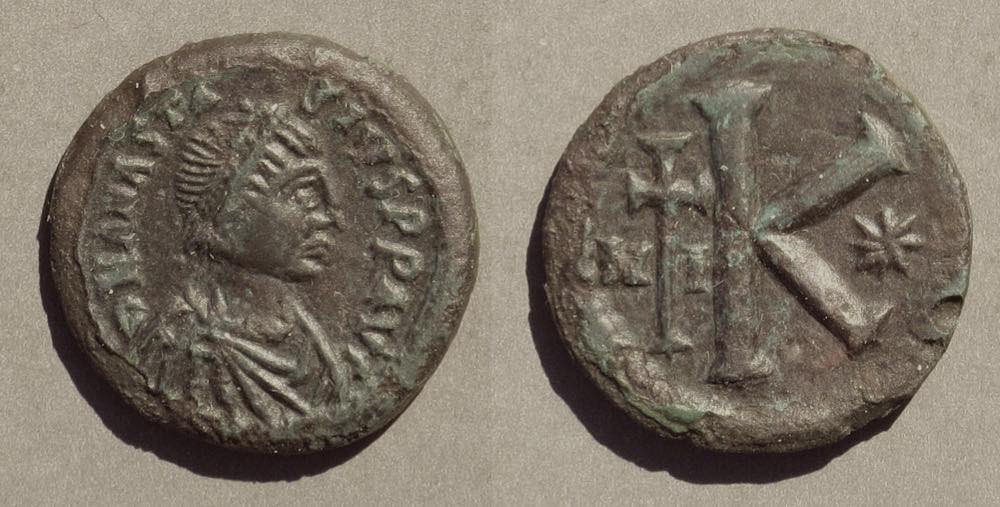 Anastasius, 491-518.
Anastasius, 491-518.20 mm. 5.09 grams. "Small module"
Large K for 20-nummus. Cross to left with N I for Nicomedia
Sear 41, from Nicomedia.
Small module denominations are scarce.
Byzantine Emperors on Coins, AD 491-c.1118.
This page is page 3 of this site and shows some typical copper coins in chronological order. I highly recommend the history books by Norwich which tell the stories of the emperors.
Note: Larger coins have larger images, but not in proportion. Very large coins have their relative image sizes reduced, and very small coins have their relative image sizes increased.
What's new on this page? 2025, Feb. 21: A coin of Leo V alone. Image sizes increased.
2024, Coins of Philippicus and Anastasius II, successors of Justinian II.
Other pages: Page 1 outlines the coinage and discuss dates and mints.
Page 2 is "Byzantine-Coin Letters, Numerals, Denominations, and Dates."
The current page is page 3 which covers emperors from 491- c. 1118.
This page has links to maps of the empire every 100 years.
Page 4 is "Late Byzantine AE, 1059-1204" (Constantine X to the fall of Constantinople to the crusaders.)
Page 5 is "Byzantine Coins, 1204-1453."
There is a page "Byzantine-coin legends. How to read Byzantine coins."
There is a page about recommended reference works.
Skip down to 582, Maurice, or 610, Heraclius, or 685, Justinian II, or 717, Leo III (beginning the iconoclastic period) or 813, Leo V, or 829, Theophilus, or 867, Basil I, or 886, Leo VI, or 969, John I, or 1081, Alexius I.
Anastasius (491-518). The widow of his predecessor Zeno selected Anastasius to be the next emperor. He was frugal and died peacefully leaving the treasury with 320,000 pounds of gold--enough to finance most of the grandiose plans of the second-next emperor, Justinian.
 Anastasius, 491-518.
Anastasius, 491-518.
20 mm. 5.09 grams. "Small module"
Large K for 20-nummus. Cross to left with N I for Nicomedia
Sear 41, from Nicomedia.
Small module denominations are scarce.
Here is an off-site map of Europe in AD 500. (The Byzantine Empire is in pink and includes the east half of the Roman Empire.)
Justin I (518-527). Anastasius died without picking a successor. Justin I, 518-527, a successful general, was chosen by the army to succeed Anastasius.
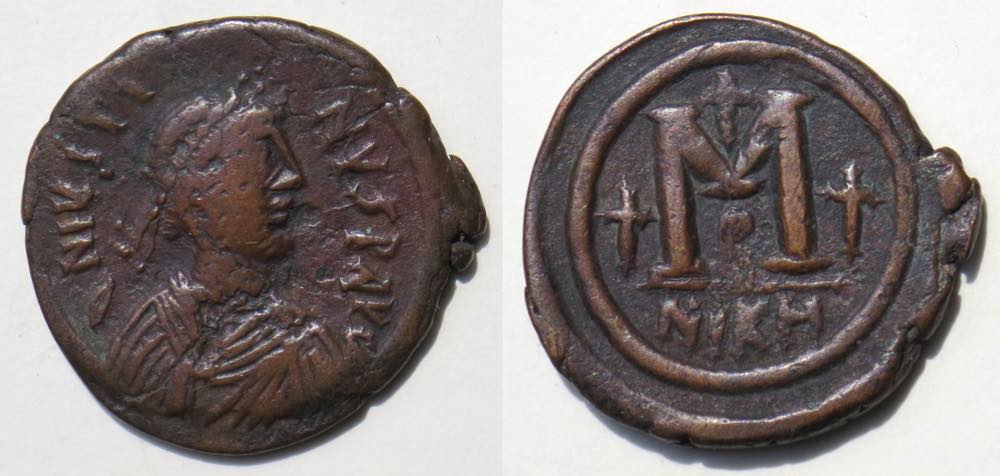 Justin I, 518-527.
Justin I, 518-527.
Large, heavy follis.
36-33 mm. 15.90 grams.
DN IVSTI-NVS P AVG
NIKM for Nicomedia.
Sear 88.
Justin chose his nephew Justinian to succeed him and there are rare coins from the few months when they reigned jointly.

Justin I & Justinian, joint reign.
29-27 mm. 15.16 grams.
4 April - 1 August, 527.
DN IVSTINVC DN IV ....
Sear 127, Nicomedia mint.
Justinian (527-565). Justinian is one of the most interesting rulers of all time. He built the magnificent Church of Hagia Sophia in Constantinople. He reconquered North Africa, Sicily, and Italy from the Vandals and Goths. He survived the "Nika Revolt" with the help of his beautiful wife Theodora. The plague raged in the empire several times during his reign, which also experienced earthquakes and a war with the Sasanians. He was the subject of a favorable biography by his contemporary Procopius and later subject to the most damning biography possible ("Secret History") by the same author! Those two books prove that history is not fixed, but can be "spun" by authors. We can understand why a historian would praise a ruler in power, but we don't know why Procopius decided to rewrite the same story in the most extreme negative light.
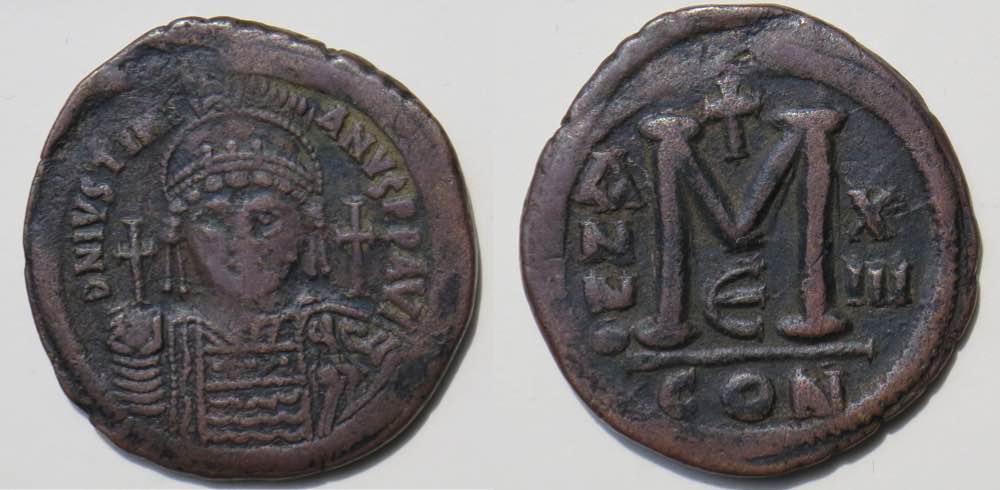 Justinian, 527-565
Justinian, 527-565
Very large, massive coin. [Photo reduced in proportion to the others--it's too big!]
40 mm. 22.84 grams. (Larger than a US silver dollar)
Justinian reformed the copper coinage in his year 12, 538/9. He increased the size, changed the busts which had been profile busts to facing busts, and added the regnal-year date. This coin is ANNO (year) XIII (13) which is 539/540.
The "Є" is "5" in Greek and is the number of the officina (workshop of the mint).
CON for Constantinopolis.
Sear 163.
Justin II (565-578). Justinian was succeeded by his nephew, Justin II, 565-578, who became seriously mentally ill and relied upon his wife, Sophia, and later on Tiberius II, Caesar from 574, who with Sophia effectively ruled under Justin II for the last four years before Justin II died.
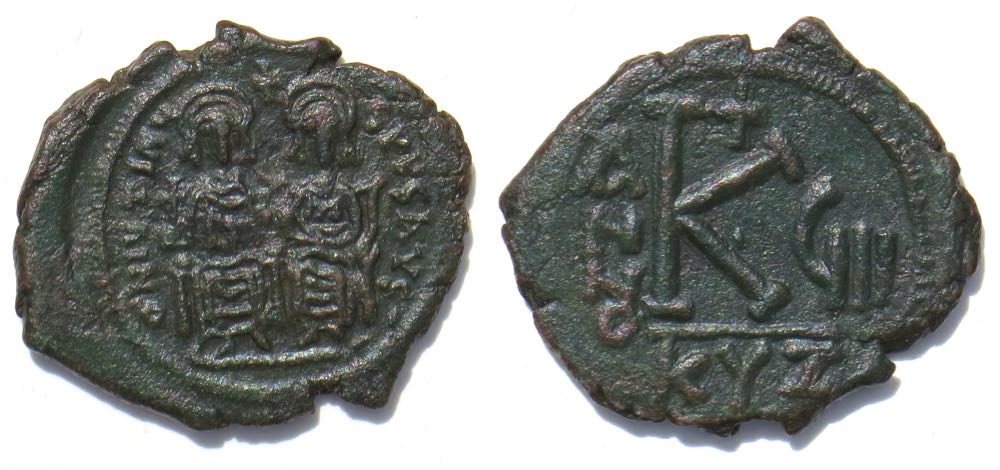
 Tiberius Constantine a.k.a. Tiberius II, 578-582.
Tiberius Constantine a.k.a. Tiberius II, 578-582.
30 mm. 13.41 grams.
Struck year 8 (GII = 6+2 = 8, reckoned from when he became Caesar under Justin II).
Legends are usually blundered but "TIb CON" can be seen on this one 9:00-11:00.
Tiberius holds a mappa in his left hand and an eagle-tipped scepter in his right.
Rounded uncial "m" (instead of an angular "M")
NIKO(media) mint.
Sear 441.
Maurice (582-602). Tiberius II chose Maurice as his successor and gave his daughter in marriage to Maurice.
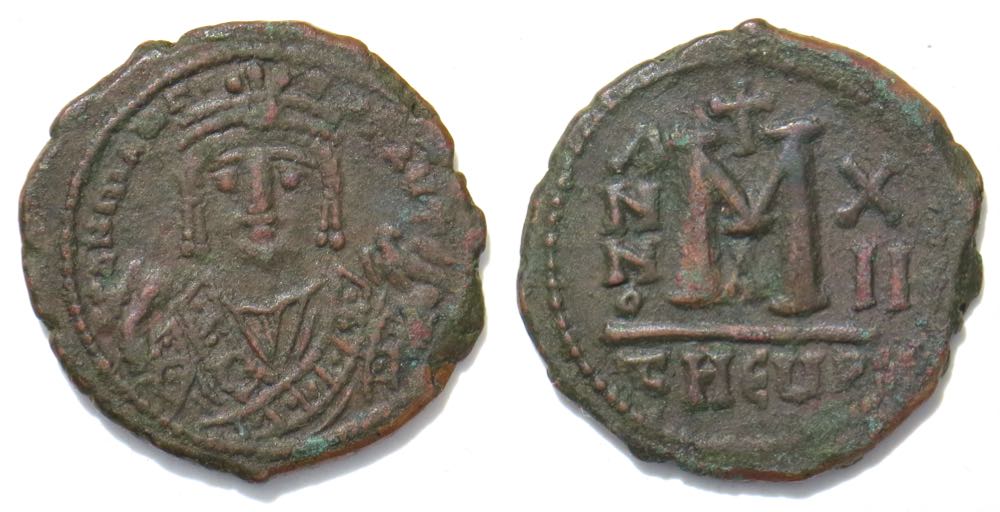
For some unknown reason the remote mint of Cherson (in Crimea in the north Black Sea) decided to reckon values in pentanummi (5-nummus) coins so their "H" on coins, which is 8 in Greek, was 8 pentanummi, or the usual 40-nummus follis.
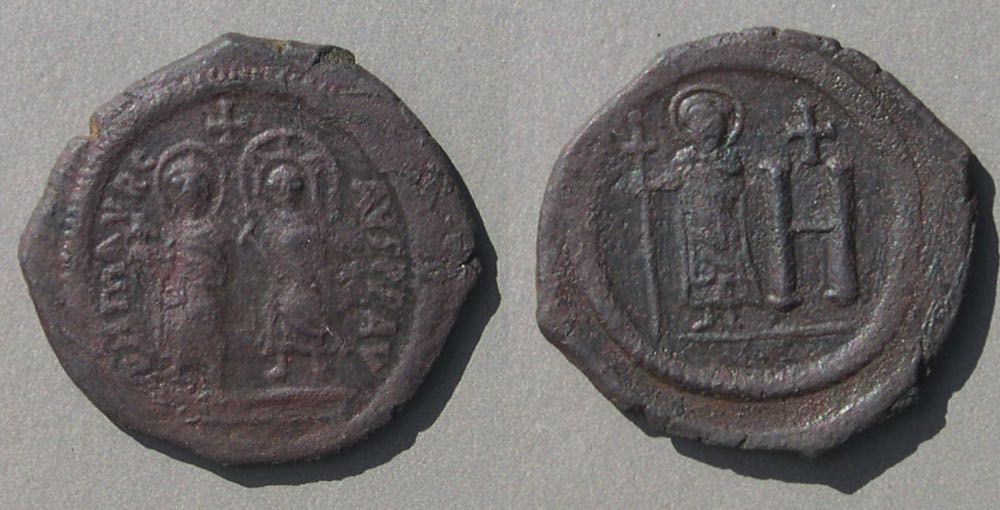
Maurice, 582-602.
32-30 mm. 11.45 grams.
DNMAVC-AVSPPAV (MAVCAVS is Maurice, blundered)
Maurice and his wife nimbate (with halos)
Uncertain standing figure, large "H" for "8" to the right.
8 x 5 = 40 nummi.
Sear 607
There are very similar coins with legend XEPCωNOC = Cherson(os) with only the name of the mint and not the name of the ruler. Various numismatists have tried to explain why and when the name of the emperor was omitted, but no consensus has emerged. See my site for more on the Cherson mint.
Here is an off-site map of Europe in AD 600. (The Byzantine Empire is in pink. North Africa and parts of Italy were added to the empire under Justinian.)
Phocas (602-610). Tiberius II was too generous. His unnecessarily extravagant gifts had left the treasury empty. The income during the reign of Maurice was not enough to support the military at the level required. He even had to decrease its rations. That was too much to bear and discontent in the army led to the overthrow of Maurice and installation of Phocas in 602.
 Phocas, 602-610.
Phocas, 602-610.
26-24 mm. 9.79 grams.
DN FOCA NЄPЄ AV
(We spell "Phocas" with "Ph" but his coins spell it with "F".)
Holding mappa and eagle-tipped scepter.
THEUP is a mintmark for Antioch under its new name, Theopolis.
Date ANNO UIII = year 8 = 609/610.
Sear 672.
At Antioch in years 1-7 he is depicted alongside empress Leontia, but in year 8 he is depicted alone.
Maurice had helped the Sasanian King Khursru II (aka Chosroes II) gain his throne. Chosroes used the overthrow of his benefactor Maurice as excuse to invade. By 608 much of Asia was overrun and a forward part of the Sasanian army was across the straits within sight of Constantinople. Also, the Balkans were under attack from the Slavs and Avars. Furthermore, Phocas initiated religious persecutions that inflamed the Byzantine population of the east against each other. The situation of the empire was dire.
Phocas turned out to be a drunken and cruel ruler who tortured and executed many of his closest associates, including his brother, his son, and his best general. His reign of terror provoked plots against him, several of which were exposed, which led to even more torture and deaths. In 608 the elderly Exarch of Carthage, Heraclius, revolted and put his son, also named Heraclius—the one who became the next emperor—in charge of the navy. Building a fleet and gathering allies took almost two years, but when he got to Constantinople in 610 there was no battle—Phocas was dragged into his presence two days later and executed.
In the interval between the declaration of the revolt and the crowning of Heraclius as emperor rare coins were issued that showed the two Heraclii not as Augusti or even as Caesars, rather as Consuls. The younger Heraclius became one of the most significant Byzantine emperors, reigning 610-641.
The Revolt of the Heraclii (608-610):

Heraclius and his father, as consuls.
30.27 mm. 9.11 grams.
Struck at Alexandretta.
∂MN ЄRACLIO CONSULII [Note how they are not claiming to be Augusti]
Facing busts of Heraclius (on left) and his father (on right) in consular robes, not crowned.
Large M, ANNO left, + above, X/IIII right,
AΛЄΞANΔ in exergue.
Sear 722.
MIBEC (II) Revolt of the Heraclii 16.
DOC 2.1 “Interregnum, Revolt of the Heraclii” 16.
Grierson attributes it to the mint of Alexandretta (20 miles north of Antioch, on the coast) on the grounds of find spots, which are overwhelmingly from that region (the patina of this one supports it), and the fact that Alexandria in Egypt never used the “M” denomination. The date is unusual. Heraclius did not want to use the regnal date of Phocas and was not yet emperor so he did not have his own regnal date. It is an indiction date. Some exist for year XIII, 609/610, and this one is year XIIII, 610/611.
Heraclius, 610-641
27 mm. 11.05 grams.
DNhЄRACI - ....HIVS...
The obverse legend is blundered (which is typical for the period).
It seems to be year 1. The coin is overstruck on a coin with a * (above the O in NIKO) which might be a coin of Justin I (Sear 630).
Sear 833
NIKO for Nicomedia.
Heraclius was energetic and capable. However, before he could get going, the Sasanians under Khrusru II had overrun Antioch, Damascus, Jerusalem, and Alexandria. They even issued coins at Alexandria that closely resembled Byzantine coins from that mint.
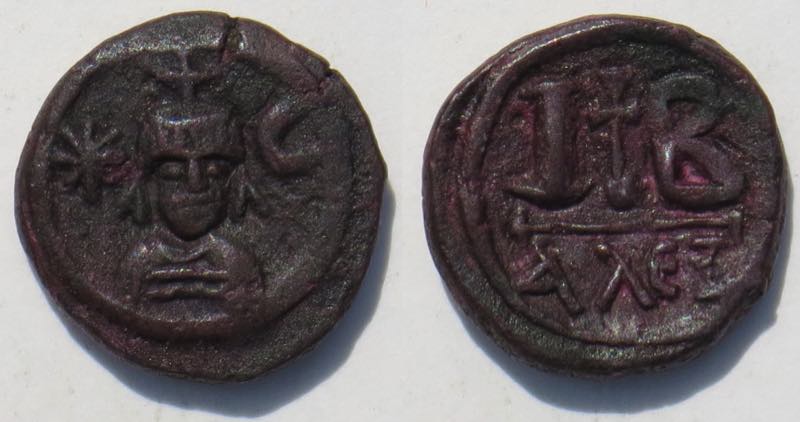 Sasanian occupation of Alexandria, 618-628
Sasanian occupation of Alexandria, 618-628
18 mm. Thick. 6.16 grams.
Facing bust (of Khusrus II?)
I+B over AΛЄΞ
Sear 855
In 614 when Jerusalem was captured the Church of the Holy Sepulcher was destroyed, most Christian inhabitants were killed, and the True Cross was taken. Before this disaster could be avenged, Heraclius had to reorganize the remaining parts of the empire to assure their survival by dividing the west into Themes under military supervision instead of civilian supervision. Money was raised from imaginative sources. For the first time even the Church contributed. In 622 Heraclius was ready. In a very complex campaign (even the Khazars were enlisted) fought on three fronts, the Sasanians were beat back from the walls of Constantinople in 626 while Heraclius won many victories in the east. He marched to the Sasanian capitol Ctesiphon and destroyed it in 627. Khursu II was overthrown and executed by one of this sons who signed a treaty giving the Byzantines back everything from before the conflict including the conquered provinces and the True Cross.
 Khusru II, Sasanian King, 590-628
Khusru II, Sasanian King, 590-628
32 mm. Thin silver drachm. 4.13 grams.
Bust of Khrsru II right with his distinctive tall winged helmet decoration.
The legend outside the rim at 4:00 to 5:30 says "good" (silver).
Two attendants either side of a Zoroastrian file altar.
Sellwood Type II 62.
Sasanians minted broad, thin, silver drachms. Very many survive in excellent condition. Gold is rare. Sasanian silver is many times as common as Sasanian copper which is often in poor condition.
Had the reign of Heraclius ended in 628 (it actually ended in 641) he would be regarded as the most successful Byzantine emperor. However, Mohammed migrated from Mecca to Medina (then known as Yathrib, now in Saudi Arabia) in 622 which began the Moslem era. Arabs burst out the desert and conquered neighboring lands amazingly rapidly. Syria was invaded in 632 and in 638 Jerusalem was conquered. The Byzantine-Sassanian war had exhausted both combatants and left them unable to resist Arab expansion. By 637 the Arabs had conquered the Sasanian capitol and the treasury, pushing the remaining Sasanian warlords to the east where they were extinguished by 651.
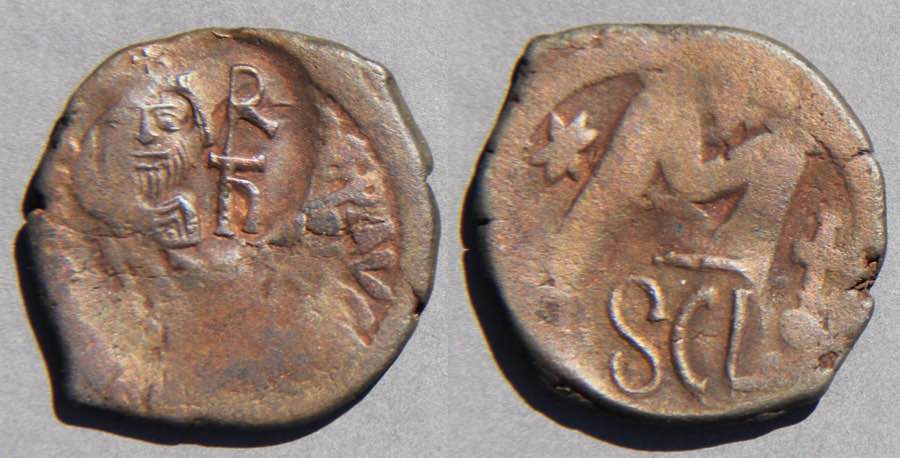 Heraclius, 610-641.
Heraclius, 610-641.
34-31 mm.
A earlier coin of Justinian overstruck by a two-sided countermark.
The bust of Heraclius and his monogram
SCL, with a bar above for Sicily.
Sear 882, struck on Justinian Sear 161.
Many Byzantine coins were struck on earlier coins. At first, this "type" from Sicily was overstruck on large folles. It was not long before similar strikes were on flans barely larger than the countermark.
Heraclius issued many coins with three figures on the obverse.
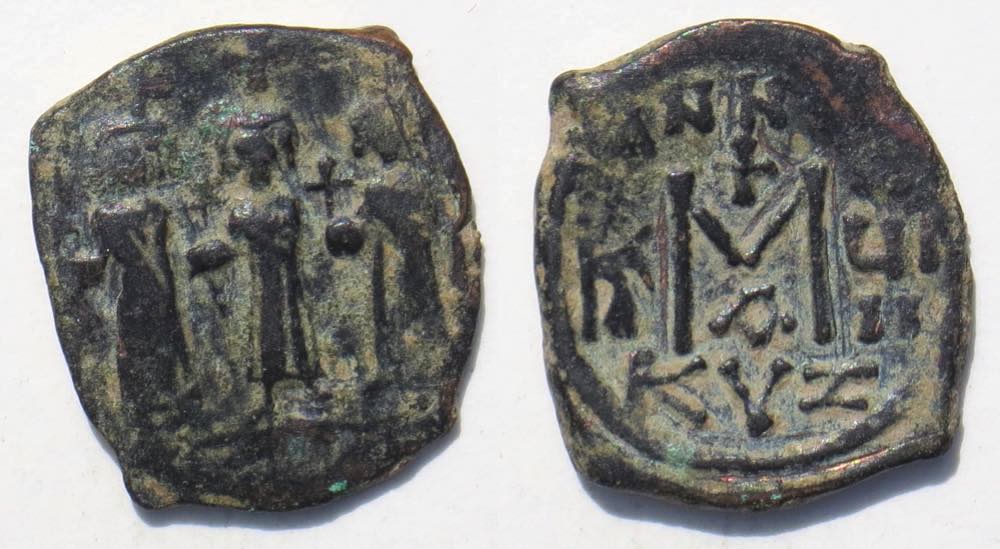 Heraclius, his wife Martina (right), and son Constantine (left).
Heraclius, his wife Martina (right), and son Constantine (left).
26-23 mm. 5.84 grams.
Large M with + and ANNO across the top
Monogram of Heraclius to left, X/UI/II to right
KVZ for Cyzicus in exergue.
Sear 841.
When the Arabs conquered Syria their first coins imitated Byzantine types. This type, with three standing figures, was commonly imitated.
When Heraclius died his will (possibly dictated by Martina, his wife) gave the empire to Martina and his sons Constantine and Heraclonas. Martina tried to assume power. Constantine was an invalid and died (was poisoned?) after only three months. Martina and Heraclonas were left, but very unpopular, partly because of their support of a heresy. Demonstrations resulted in Martina and Heraclonas being disfigured and Constantine's 11-year old son elevated. His name had (also) been Heraclius but he took the name Constans (II) and began rule under the regency of the Senate. (A note on how to pronounce "Heraclius".)
Constans II (641-668). After Heraclius battled the Sasanians and then the Arabs, the empire was much weakened and it shows in the coins which are of much-reduced quality. The coins are smaller and lighter, the flans are irregular, and workmanship is poor both in engraving the dies and striking the coins.

Constans II, 641-668
Follis. 23-19 mm. 6.76 grams.
Sear 2005, at Constantinople.
It may be hard to believe, but this ragged coin is better than most under Constans II.
For the next 60 years most coins are in terrible condition. It can be hard to identify who issued them. The Arabs had conquered Asia and most of north Africa. The Slavs occupied much of the Balkans. Constantinople was under continuous threat. In 663 Constans decided to move the government to Syracuse, Sicily, and stabilize (and remove the riches from) Italy. For five years the government was in Sicily and coins from Sicily are common.
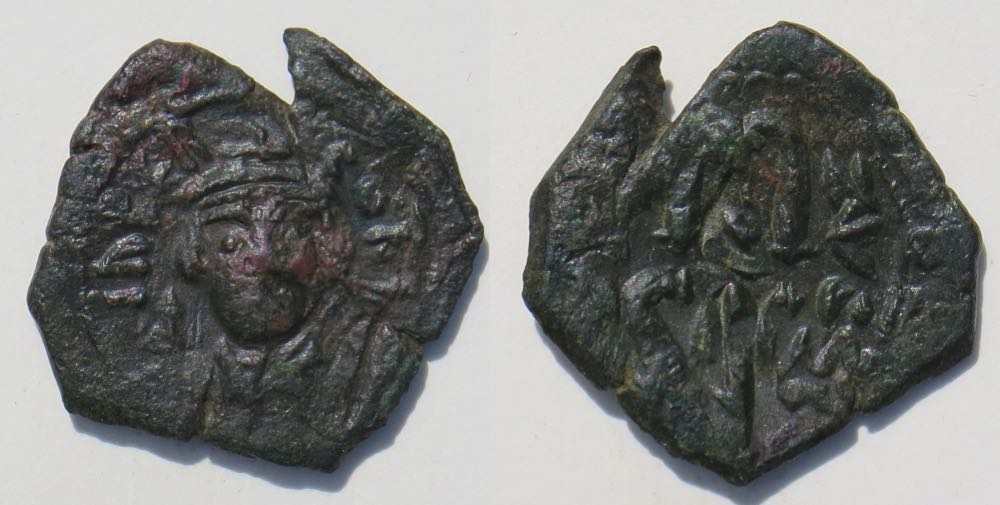 Constans II
Constans II
27 mm. 6.54 grams.
Heraclius minted many coins in Sicily with a large "SCL" countermark. Constans continued the coinage with similar countermarks and then coins like this one with a large "SCL" as mintmark below an m (of size reduced to leave space for the large mintmark).
Sear 1103. Sicily
Sear lists dozens of copper types for Constans II and almost none of the coins have a clear legend. Only a few have the quality of strike of the next coin from the Syracuse mint.
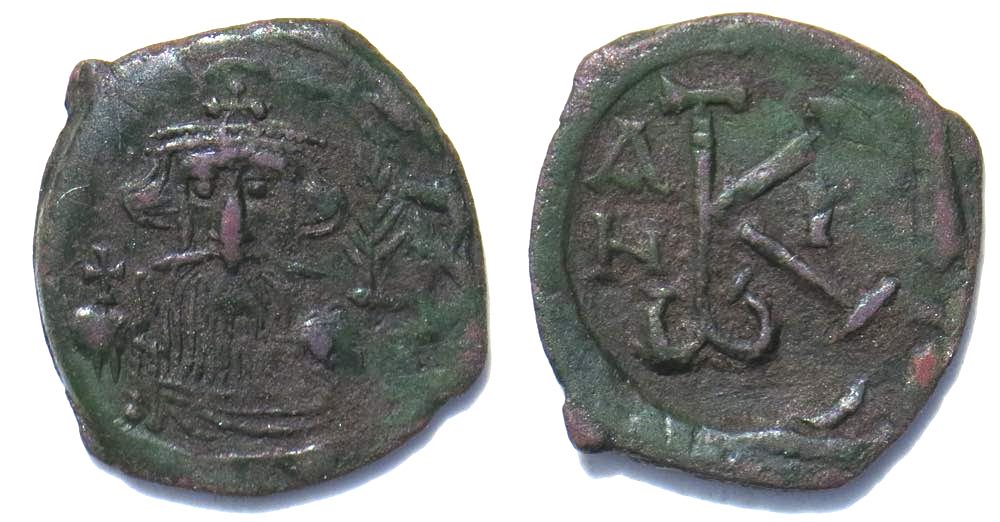 Constans II, 641-668
Constans II, 641-668
24 mm. 4.38 grams.
Long bearded Constans II facing, holding globus cruciger, palm branch to right
AN to left of Monogram of Constans, I to right.
(I = 10, the indictional year 651/2).
Indictions were 15-year fiscal periods. Few Byzantine coins were dated by indictional years, but we know Sicilian coins of Constans II were.
Sear 1113, at Syracuse, Sicily.
Coins of Constans II, especially gold coins, often show him with a very long beard.
Constantine IV (668-685). While Constans II was in the west, his eldest son, Constantine IV, was holding the empire in the east. In 661 the Caliph was assassinated and the resulting turmoil in the Arab world left Constantinople without conflict with the Arabs until 672. By then Constantine IV had succeeded to the throne. With stout walls and Greek fire Constantinople withstood five years of siege. When the Arabs left in exhaustion, Constantine was able to turn his attention to the Bulgars filtering in across the Danube and to a lingering dispute about Christian doctrine.
 Constantine IV, 661-685
Constantine IV, 661-685
23 mm. 3.23 grams.
Cross, large I, K
10-nummus piece.
Sear 1182, at Constantinople.
Constantine IV reformed the coinage to reintroduce a large-diameter follis. It is usually poorly struck, but its 37-40 mm size makes it very impressive.
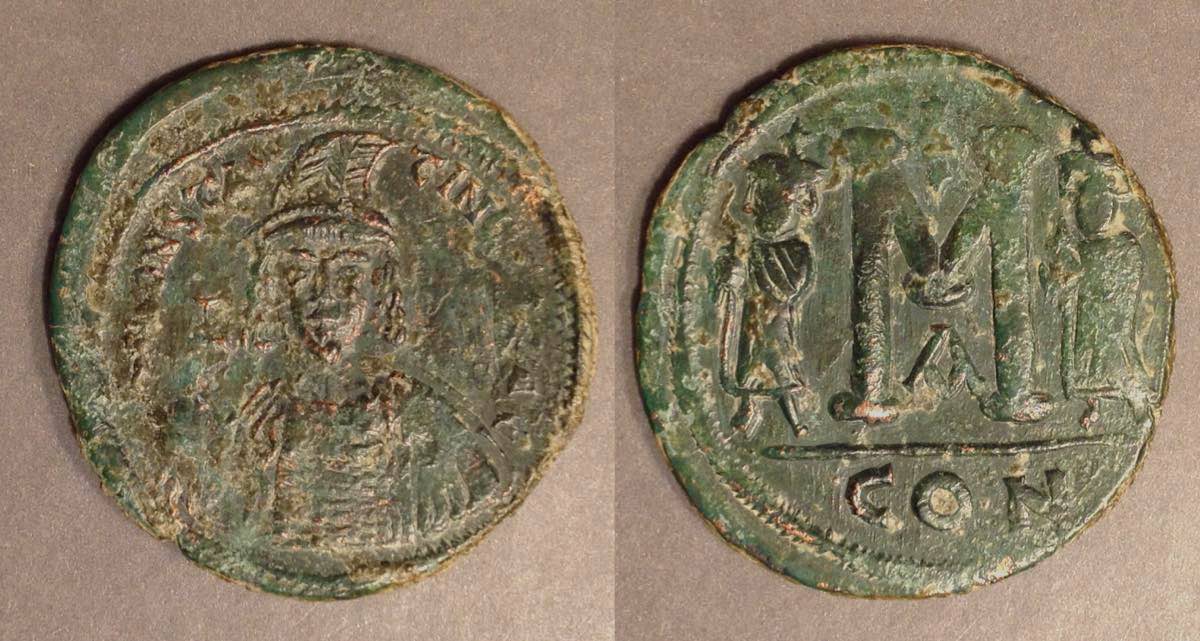 Constantine IV, 661-685
Constantine IV, 661-685
37 mm. 17.62 grams.
The helmet with a plume which curves to the viewer's right distinguishes Constantine IV.
Two figures either side of the M.
CON in exergue.
Sear 1173.
MIBEC Constantine IV 77.
Justinian II (685-695 and 705-711). Constantine IV had Justinian (II) when he was 17. In 685 Justinian inherited the throne. His coins are almost all poor, but his story makes his coins desirable. When he was deposed at the end of his first reign in 695 he was not killed. Byzantine emperors, representatives of Christ on earth, were supposed to be without significant blemish. Cutting off Justinian II's nose and banishment was thought to be enough to preclude his return to the throne. However, they didn't reckon with the resourceful and vengeful Justinian II! After ten years of scheming to make alliances with barbarians he returned to Constantinople with an Bulgarian army at his back and took the throne (and a great deal of vengeance). Justinian II has both first- and second-reign coins.
 Justinian II, first reign, year 2, at Constantinople.
Justinian II, first reign, year 2, at Constantinople.
25-23 mm. 9.61 grams.
Facing bust, cross to right, globus cruciger in left.
A +
N II either side of the M, A below
N -
CON
Sear 1260, from Constantinople.

Tiberius III (698-705). The Muslims captured Carthage in 698. The naval expedition under Aspimir that was sent to relieve Carthage failed and rather than return in disgrace Aspimir rebelled, returned to Constantinople at the head of his fleet, became emperor, and changed his name to Tiberius (III).

Tiberius III, 698-705
17 mm. 2.56 grams.
Monogram of Theodosius above M flanked by palm branches
Sear 1395.
Here is an off-site map of Europe in AD 700. (The Byzantine Empire is in pink. Africa has been lost to the Arabs. Some of the Balkans have been lost. Much of Italy has been lost, and the eastern border of the empire has retreated somewhat.)a
Coins of Justinian II are common, although usually in poor condition. The difficulty of finding a nice one combined with the historical interest of his reign make good examples expensive.
Philippicus, Bardanes (711-713). The coins of Justinian II's successors also tend to be in poorly struck and poorly preserved. They are even more difficult to find in nice shape because they had short reigns and their coins are rare. Coins of Phillipicus, Anastasius II, and Theodosius III are in high demand and expensive if at all legible.
Philippicus successfully revolted against Justinian II but his religious policies were unpopular and the empire had military disasters. The Bulgarian army got to the walls of Constantinople. In a military coup he was blinded and sent to a montestary, and one of his staff (not a general) was selected to be emperor. He took the name "Anastasius [II]"--it is a little like modern Popes picking their own Papal names--perhaps thinking that he, too, was a civil servant.
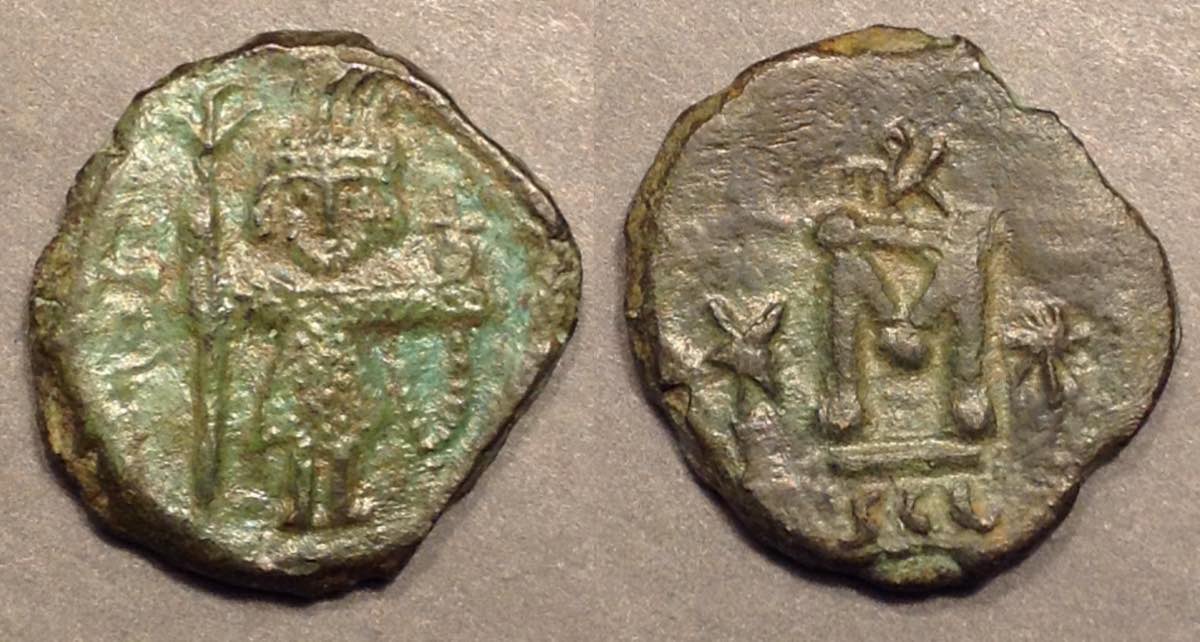 Philippicus (711-713)
Philippicus (711-713)
21.5-19 mm. 6.79 grams.
M with stars either side, monogram above, and SCL (for Sicily) below.
Sear 1460A.
MIBE III Philippicus 24, plate 49, page 277. This example is among the finest known.
Anastasius II (713-715). The Byzantine army had factions and one faction overthrew Anastasius after a 6-month-long seige of Constantinople. He was permitted to retire (wihout being mutilated or blinded) to a monesatry, but not long thereafter was implicated in a conspiracy to overthrow his successor, Theodosius III. For that he was executed.
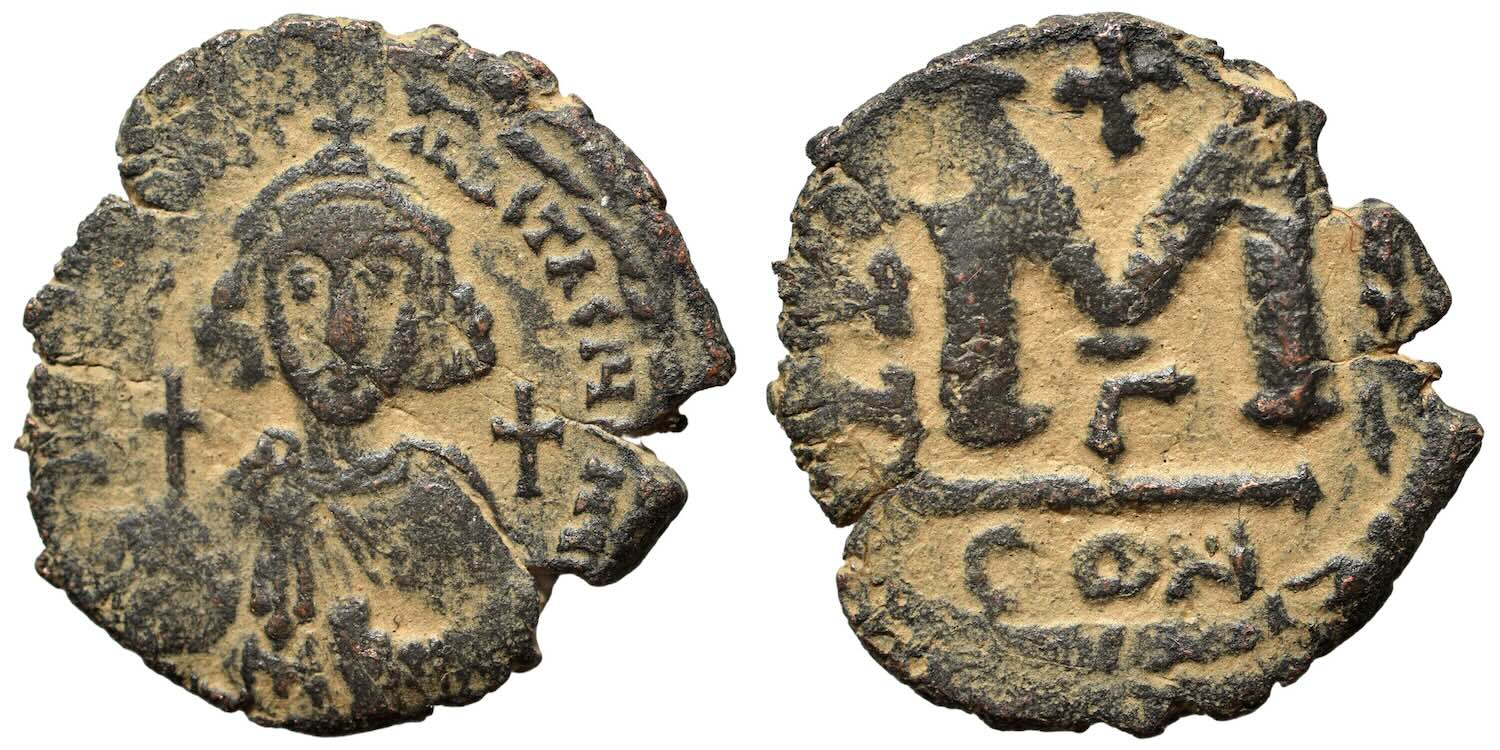 Anastasius II, 713-715.
Anastasius II, 713-715.
22-21 mm. 3.44 grams.
Facing bust with, very unusually, his name legible at 12:30-4:00
ANASTASIUS
Large "M" with "ANNO" left and "I" right.
Γ below and "CON" in exergue.
Theodosius III (715-717). Coins of Theodosius III are very rare. None are shown here.
Leo III (717-741). Justinian II was the last emperor of the dynasty of Heraclius. His second reign ended in 711. After a few short-lived emperors, Leo III ("The Isaurian", 717-741) came to power at a critical time for the empire when the Arabs were again threatening Constantinople. The city and therefore Europe were saved, but at great cost. Leo is best known for initiating iconoclasm--the prohibition of icons and any pictorial representations of religious subjects. Forbidding religious images could be justified by the Bible but was unpopular. His coins are rare and usually in poor condition.
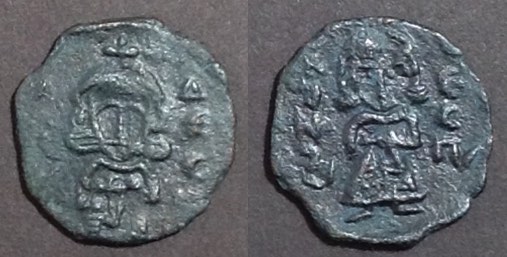 Leo III, 717-741
Leo III, 717-741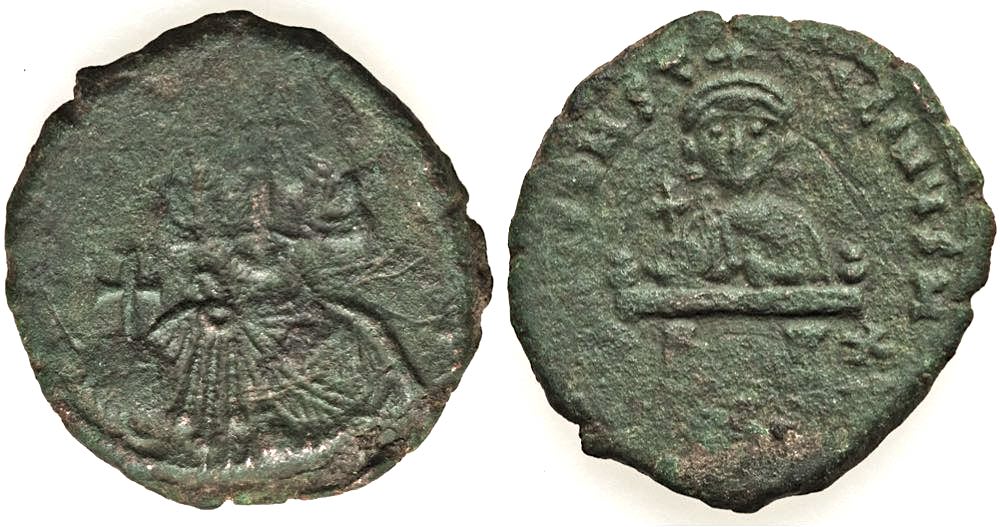
Leo III, 717-714
24 mm. 7.81 grams.
His bust facing, globus cruciger in right
small facing bust of Constantine V over large M between ANN and XX
Sear 1514
This same Sear number comes in this "large" size and a much-smaller size down to 17 mm and 2.5 grams. Most are poorly struck and in terrible condition.
Constantine V (741-775). Under Leo's son and successor, Constantine V, coins are more available, but not high quality.
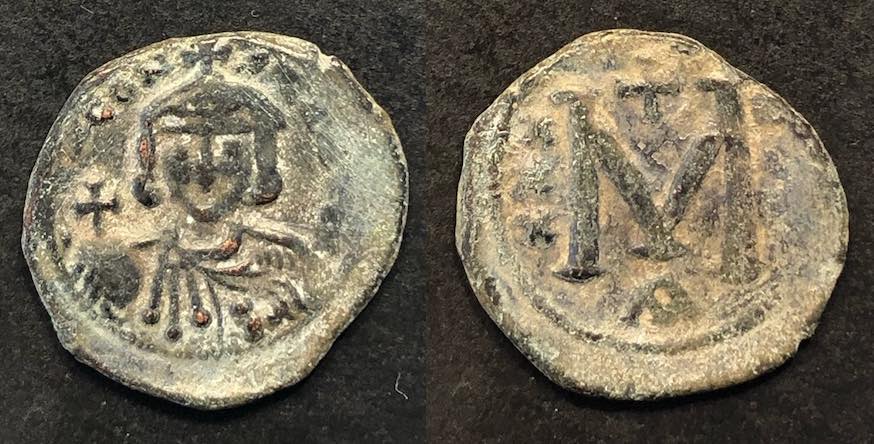 Constantine V, alone, 741-751, before he promoted his son Leo IV.
Constantine V, alone, 741-751, before he promoted his son Leo IV.
20-18 mm. 3.16 grams. Remarkably small for an "M" type.
Facing bust holding globus cruciger in right hand.
DN CON-STAN .. around.
Sear 1555. Constantinople mint.
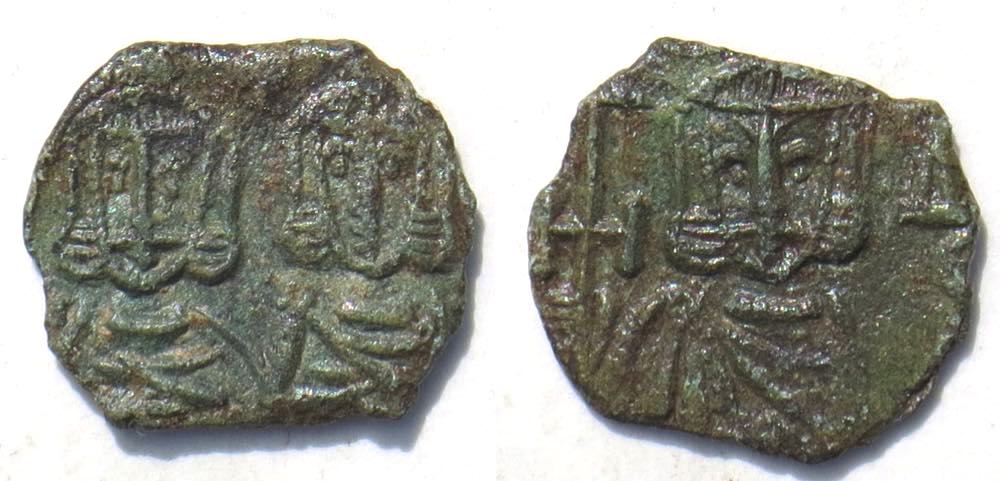 Constantine V, 741-775, and his son Leo IV, 751-775-780
Constantine V, 741-775, and his son Leo IV, 751-775-780
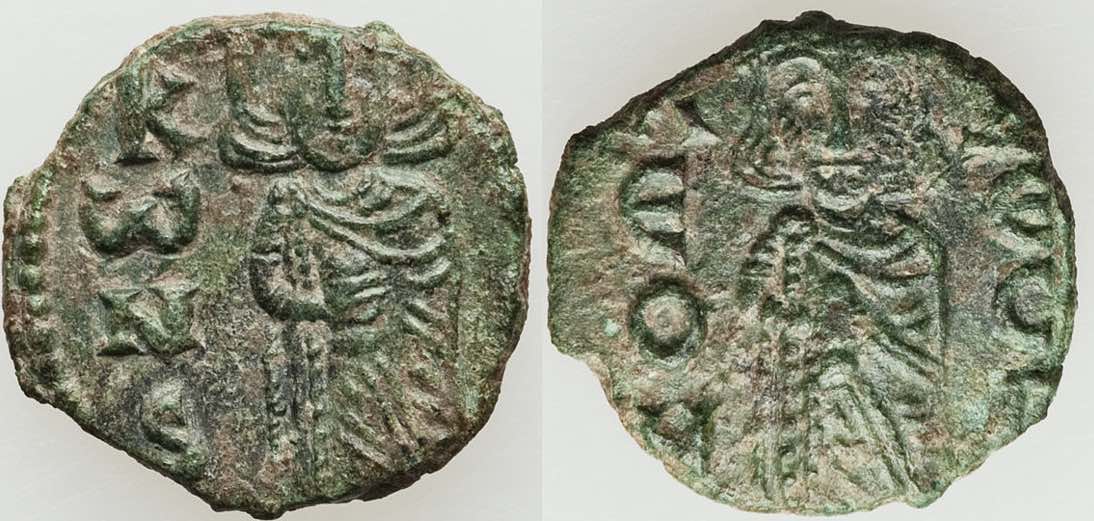 Constantine V with Leo IV, 751-775
Constantine V with Leo IV, 751-775
16 mm. 2.40 grams.
This example has their names vertically down the left:
KωNS for Constantine and ΛЄON for Leo, ΔЄCΠ = despot, down the right)
Syracuse mint, with its typical green patina.
Sear 1568.
Leo IV (775-780). Leo succeeded his father.
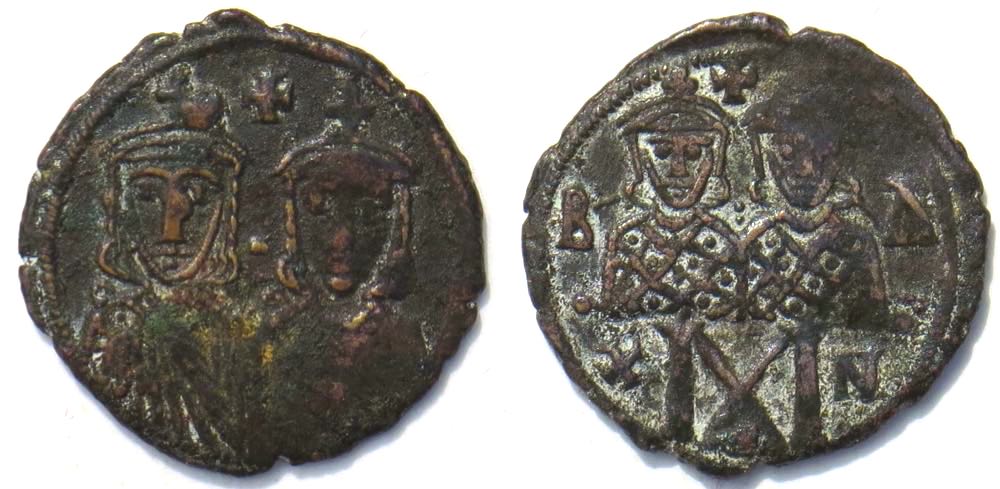
Irene (780-802). Among the many interesting rulers of the Byzantine empire is Irene, wife of Leo IV and mother of his son, Constantine VI, who became a child emperor at age 10 when Leo IV died, with Irene as regent. She was ousted and her son became emperor, but he alienated so many people that she realized he was ripe to be overthrown. She managed it and blinded her own son to assure he would not return to the throne. She became sole ruler 797-802. For the first time a woman took power in her own name. (Here is a silver coin of Constantine VI and Irene and more of the story.)
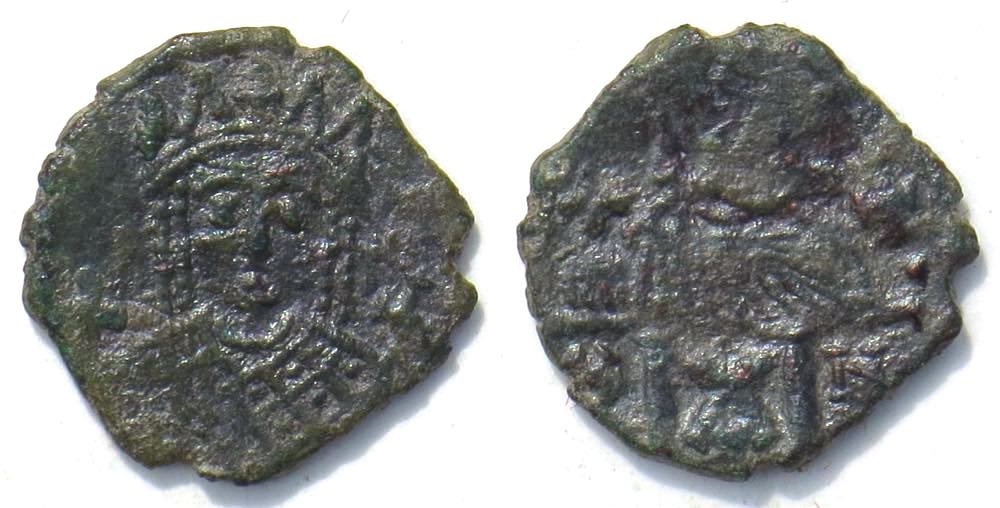
Irene (597-802) struck with her son Constantine VI, 780-797
before she ruled alone.
19 mm. 2.70 grams.
Her bust facing
Bust of Constantine VI above a horizontal line, below which
a large M with X and N either side, A below.
Struck at Constantinople.
Sear 1598
Here is an off-site map of Europe in AD 800. (The Byzantine Empire is in pink. A bit more of Italy has been lost, but Sicily retained.)
Nicephorus I (802-811). In 800 Charlemagne (of the "Holy Roman Empire") was crowned "Emperor of the Romans" by the pope. For centuries there had been no western emperor to challenge the east as the sole Roman empire. Although Irene was the legitimate ruler by eastern rules of succession, it was understood in the west that a woman could not be a Roman ruler, so the west felt the eastern throne was empty even though it was occupied by Irene. An embassy was sent to explore the possibility of Charlemagne marrying Irene and uniting the empire, but the Byzantines wanted nothing to do with a boorish and illiterate westerner. They decided they needed a male ruler--any male. So Irene was deposed and replaced by Nicephorus I.
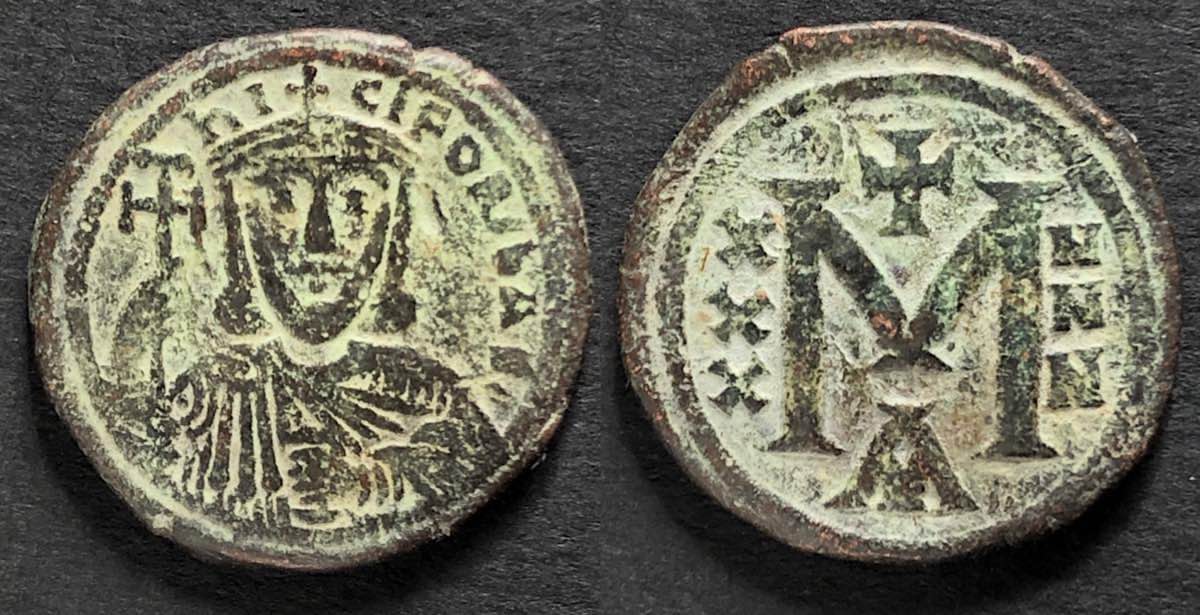 Nicephorus I, 802-811
Nicephorus I, 802-811
24-23 mm. 6.88 grams.
ҺI-CЄFORI bAS
Sear 1606
The reverse is said to be "immobilized" because it is an unchanging type used by several emperors. It resembles the formerly meaningful "ANNO year" layout, but with the meaningless XXX down the left and NNN to the right. Also, "A" is the only symbol in the position formerly held by the officina numeral.
After a year he raised his son Stauracius to co-emperor.
 Nicephorus I, 802-811
Nicephorus I, 802-811
22 mm. 5.49 grams.
Nicephorus (on left) and his son Stauracius (803-811)
Sear 1607. Constantinople mint.
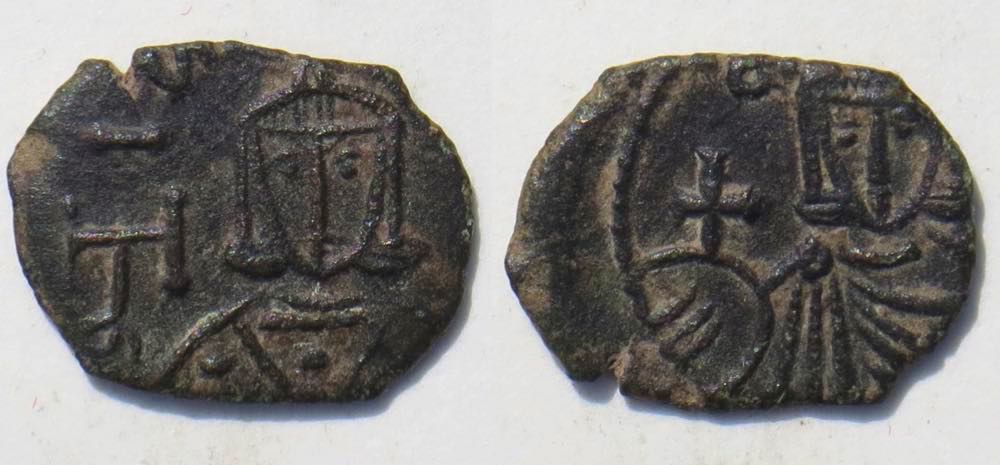 Nicephorus I with Stauracius (803-811)
Nicephorus I with Stauracius (803-811)
Michael I, Rhangabe, 811-813. Nicephorus I was the first emperor to be killed in battle since Valens (in 378). After some significant military successes against the Slavs and Bulgarians, Nicephorus managed to get himself killed and his son mortally wounded in battle against the Bulgarians. Stauracius lived on only a short while and issued no new coin types. He passed the throne to Michael I (811-813), his brother-in-law.
 Michael I, 811-813
Michael I, 811-813
22-20 mm. 3.91 grams.
MIXA-HL bASIL
The same immobilized reverse as on the previous coin.
Sear 1617. Constantinople mint.
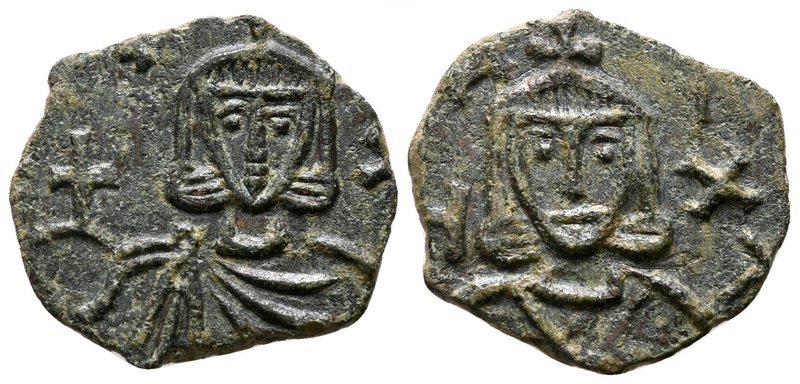 Michael I, 811-813.
Michael I, 811-813.
19-16 mm. 2.59 grams.
His facing bust in chlamys
His facing bust in loros
Sear 1624, Syracuse mint.
His portrait is on both sides, which is unusual. He is wearing a chlamys on one and a loros on the other. Also, the legend is M-IXA on both sides. ("X" is "chi" in Greek for "ch")
Leo V (813-82).
 Leo V, alone, struck July-December 813
Leo V, alone, struck July-December 813
before he raised his son to the throne.
23 mm. 5.21 grams.
Sear 1629

Portrait convention: If two rulers are portrayed, the senior ruler is on the left and usually, but not always, a bit larger. Very young rulers may be on the left but much smaller than their regents, for example Constantine VII is smaller than his regent Zoe.)
Naming Convention: If a son has the same name as other rulers, here "Constantine," usually his name is not given a number unless he later became the primary ruler. For example, Constantine VI, son of Leo IV (775-780), ruled 780-797. As the first to do so since Constantine V, he is "VI". The son Constantine on this coin did not rule alone, so he is just "Constantine" (son of Leo V), one of many Constantines without numbers.
Michael II (820-829). Michael II replaced Leo V after Leo was assassinated because of his extreme iconoclast policies.

Michael II, 820-829 and his son Theophilus
31-28 mm. 7.96 grams.
MIXAHL S Θ-ЄΟΦΙΛΟS
The Θ below might, or might not, refer to Theophilus (ΘЄΟΦΙΛΟS).
Sear 1642.
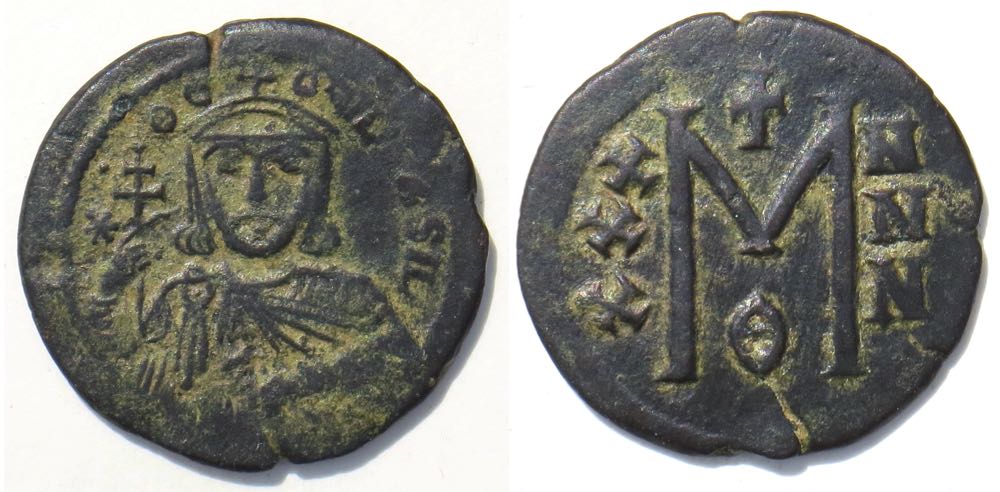 Theophilus, 829-842.
Theophilus, 829-842.
28 mm. 7.87 grams.
ΘЄ-ΟFIL bASIL (We spell it with "ph" but his coins spell it with "F".)
Struck 829-830/1 by Theophius alone at Constantinople, before the next type was issued.
The same immobilized reverse type with Θ in the place of the officina number. Again, The Θ may refer to Theophilus (ΘЄΟΦΙΛΟS).
Sear 1666
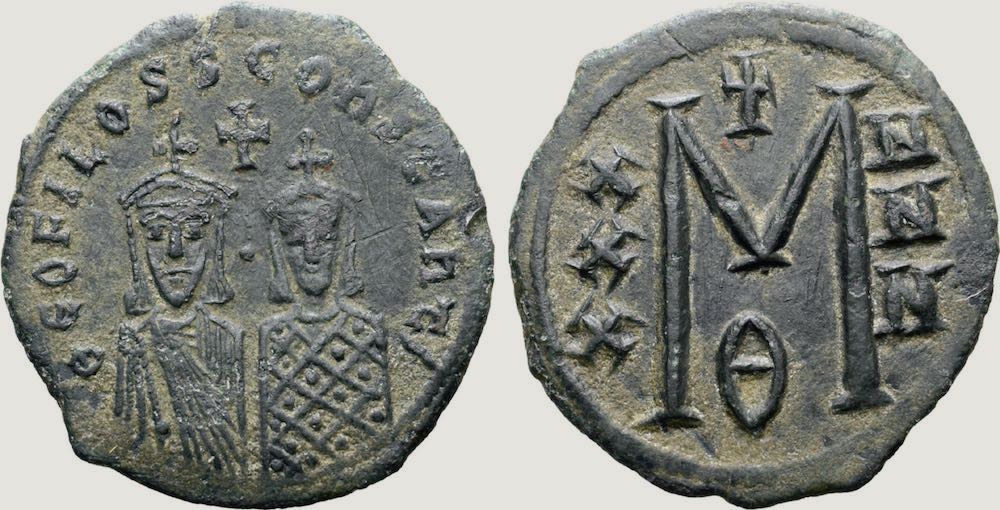 Theophilus (829-842) and his son Constantine.
Theophilus (829-842) and his son Constantine.
31-30 mm. 8.40 grams.
The coin was struck 830 or 831.
The figure on the right is Theophilus's son, Constantine.
The obverse legend names both: ΘЄOFILOS S COSTAҺC
The second S-like symbol is for "and".
In this period sons were promoted to the throne young and the portrait coins do not reflect the co-ruler's true age. In this case Constantine was an infant who died within a year, making this issue very rare.
Sear 1665, at Constantinople.
Michael III (842-867). Theophilus took ill and died in 842 leaving the throne to another infant son, Michael III. At first Michael III had his mother as regent. After she and other claimants were eliminated, in 866 Michael proclaimed Basil I, formerly a lowly stablehand, his co-emperor. Bad decision. In 867 Basil murdered Michael and assumed sole rule as the founder of the Macedonian Dynasty.
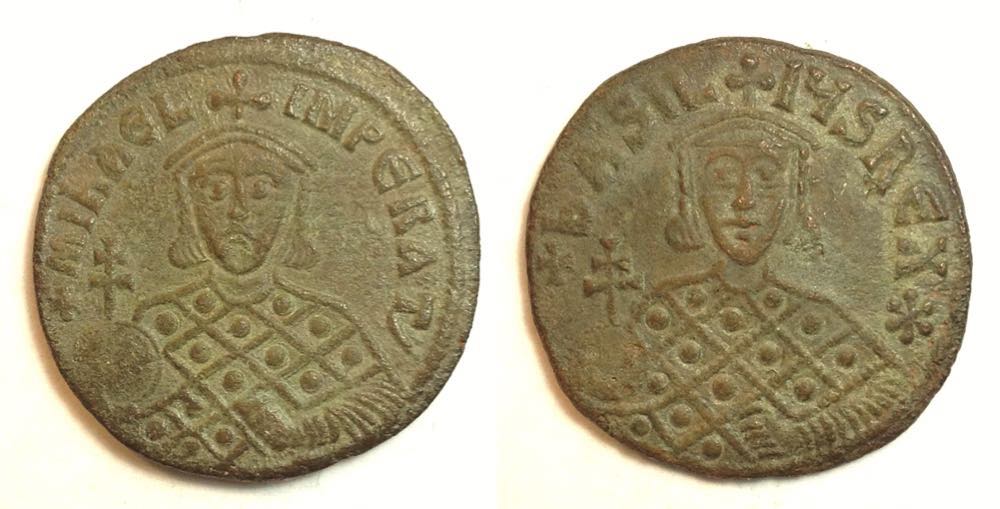 Michael III, "the drunkard," 842-867 and Basil I, 867-886.
Michael III, "the drunkard," 842-867 and Basil I, 867-886.
That is the only copper coin type of Michael III from Constantinople. It is rare. His smaller coins from Syracuse are more common.
 Michael III, alone.
Michael III, alone.
23-21 mm. 3.67 grams.
Facing bust in loros, + on crown, holding globus cruciger.
M with + above and Θ below.
Sear 1697. Syracus mint.
The same type also comes on a smaller flan.
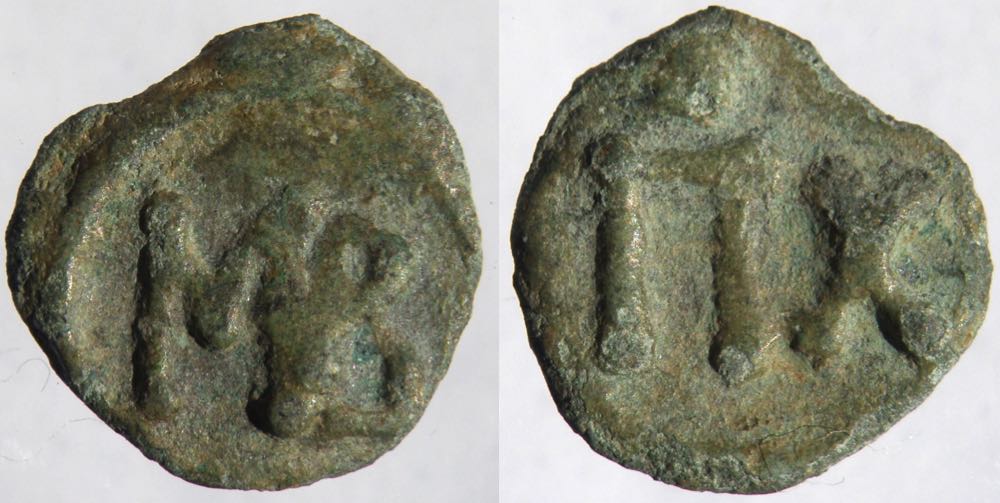 Michael III and Basil I, 866-867.
Michael III and Basil I, 866-867.
15 mm. 1.20 grams
MB for their initials
ΠX for Polis (city of) Cherson (X is a chi in Greek)
Sear 1699
There are no coins remotely like this from mints other than Cherson.
Basil I (867-886). After he murdered Michael III, Basil issued coins with his sons.
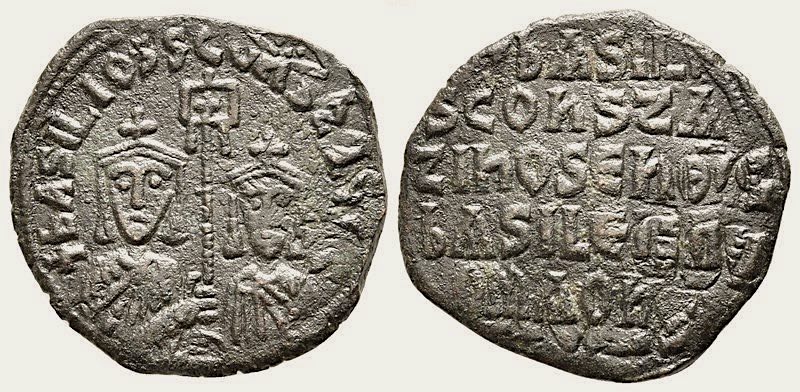 Basil I, the Macedonian, and his son Constantine Struck winter 867/8. Struck 868-870.
Basil I, the Macedonian, and his son Constantine Struck winter 867/8. Struck 868-870.
26 mm. 7.60 grams.
+bASIL/S COҺSTA/TIҺOSЄҺΘO/bASILЄ IS R/OMAOҺ
Basil and Constantine, by the grace of God, kings of the Romans
Sear 1721.
Portrait Convention: When a Byzantine coin has three figures on one side, the highest ranking person is in the middle, the second on our right, and the third on our left.
 Basil I, the Macedonian, 867-886
Basil I, the Macedonian, 867-886
with his sons Leo VI and Constantine (the eldest son, who predeceased Basil). Struck 870-879.
27 mm. 8.28 grams.
+LЄOҺ bASIL COҺST AVGG (labeling the rulers left to right)
5-line reverse legend (labeling the rulers most important to least imporant)
+bASIL (Basil)
COҺSTAҺ (Constantine)
T S LЄOҺ ЄҺ (and Leo, by the grace of God)
ΘO bASILS (King of the)
ROMЄOҺ (Romans)
Sear 1712. Constantinople mint.
The ranking emperor, Basil, is in the middle and much larger. The next is Constantine, on the right (as we see it), second in the reverse legend and slightly larger than Leo, who smaller on the left and third in the reverse legend.
After his son Constantine died he issued coins in his name alone.
 Basil I, 867-886, alone.
Basil I, 867-886, alone.
Struck 879-886, after the death of his son Constantine, according to DOC III.II, page 477, which notes that some previous scholars have put this type first, in 867-8.
25 mm. 7.01 grams.
Sear 1709.
Here is a page with more about the copper coins of Basil I.
Here is an off-site map of Europe in AD 900. (The Byzantine Empire is in pink. Sicily has been lost and the border near Antioch has retreated.)
Leo VI (886-912). Because Constantine predeceased Basil, Leo VI was next to the throne. Nicknamed "The Wise," he indulged in scholarship to the neglect of statesmanship. He produced very many coins of the next type.
 Leo VI, The Wise, 886-912.
Leo VI, The Wise, 886-912.
27 mm. 7.96 grams.
+LЄON BAS-ILЄVS ROM '
Four-line reverse legend:
+LЄOҺ
ЄҺΘЄO bA
SILЄVS R
OMЄOҺ
"Leo, by the grace of God, King of the Romans."
Sear 1729. Constantinople mint.
Constantine VII (913-959). Leo VI, the wise, did not have a male heir until his fourth wife presented him with Constantine VII. (Having four wives got Leo in a lot of trouble with the church.) When Leo died there were historical complications I omit. Then Constantine VII became emperor while still a minor, with his mother Zoe as regent.
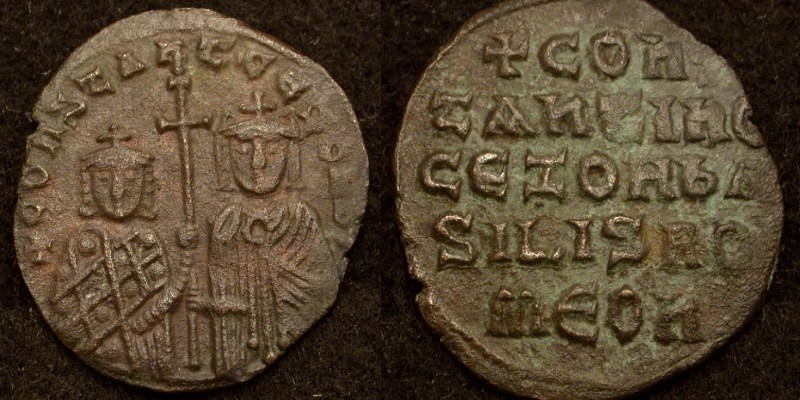 Constantine, 913-959, and Zoe. 914-919. Note Zoe is larger.
Constantine, 913-959, and Zoe. 914-919. Note Zoe is larger.
Romanus I (920-944). Invasions by the Bulgarians required the help of an able military man and the admiral Romanus I pushed himself into the role of regent and co-emperor, forcing out Zoe. He issued coins in his own name during the nominal reign of Constantine VII. (The story is Byzantine and given in more detail here.)
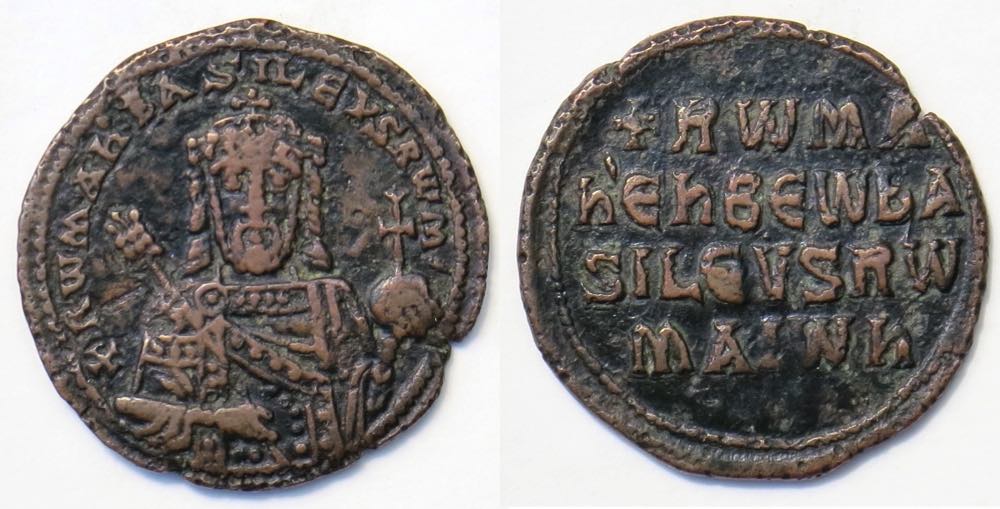 In the name of Romanus I, 920-944, under Constantine VII. 913-959.
In the name of Romanus I, 920-944, under Constantine VII. 913-959.
27 mm. 6.95 grams.
Obverse legend: + RWMAҺ BASILЄVS RWM
Reverse: +RWMA/N'ЄҺBЄW bA/SILЄVS RW/MAIWҺ
Sear 1760. Constantinople mint.
Romanus promoted his oldest son, Christopher, who was already an adult military man, to co-emperor and then his other two sons too. Constantine VII was moved down the list of heirs. However, Christopher died and Romanus became despondent, seeming not to care for his other two sons, and wrote a will that would have given the empire (back) to Constantine VII. The sons conspired and overthrew him, forcing him to take vows and join a monastery. Shortly thereafter, the populace backed Constantine VII and overthrew the sons and forced them to join their father (in 945).
So, the coins of Romanus I were called in and restruck as coins of Constantine VII. (The story of Constantine VII and Romanus is on its own page.)
 Constantine VII, alone, 945-950, after Romanus I was deposed.
Constantine VII, alone, 945-950, after Romanus I was deposed.
26-25 mm. 9.22 grams.
+COҺST bA-SIL' ROM'
+COҺST
ЄҺΘЄObA
SILЄVSR
OMЄOҺ
Sear 1761.
In 950 Constantine VII began to issue coins with his own young child, Romanus II.

Constantine VII and Romanus II (945-963),
struck c.950-959 [That is, until Constantine VII died.]
27-25 mm. 7.68 grams.
COҺST CЄ ROMAҺ b ROM
Their facing busts.
COҺST'/ЄE ROMAҺ/ЄҺ XRIST/b ROMЄO
Sear 1762 under Constantine VII. Constantinople mint.
Nicephorus II (963-969). Romanus II, 959-963, died young and the only copper type given to him in Sear (Sear 1775) is from Cherson and has been reattributed to Romanus I by Russian scholars. The mother of Romanus II was named regent and she married Nicephorus II, Phocas, 963-969, a successful general.
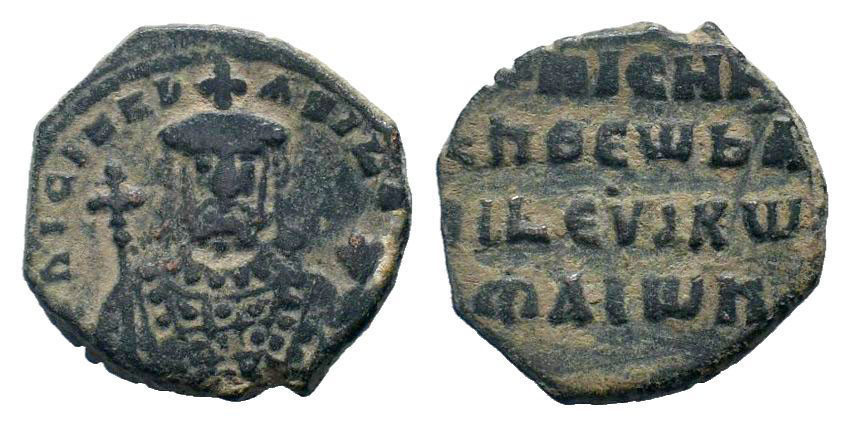 Nicephorus II, 963-969.
Nicephorus II, 963-969.
23 mm. 7.37 grams.
ҺICIFR b-ASIL
Facing bust of emperor.
Four-line reverses legend:
+ҺICHF
ЄNЄWbA
SILЄVS RW
MAIWҺ
Sear 1783
In this era many coins are overstruck on coins of the previous reign. Next is an example of that type overstruck on an easily-identified coin of Constantine VII alone. Photos show it with the overtype upright and then with the undertype upright.
 Nicephorus II, 963-969, overstruck on a coin of Constantine VII (913-959)
Nicephorus II, 963-969, overstruck on a coin of Constantine VII (913-959)
29-28 mm. 8.20 grams.
ҺICIFR ... from 9:00
Facing bust of Nicephorus II
Four-line reverse legend:
+ҺICHF
ЄNЄWbA
SILЄVS RW
MAIWҺ
Sear 1782 overstruck on Sear 1761 of Constantine VII alone. To see the undertype, next is the same coin rotated to make the undertype upwards.
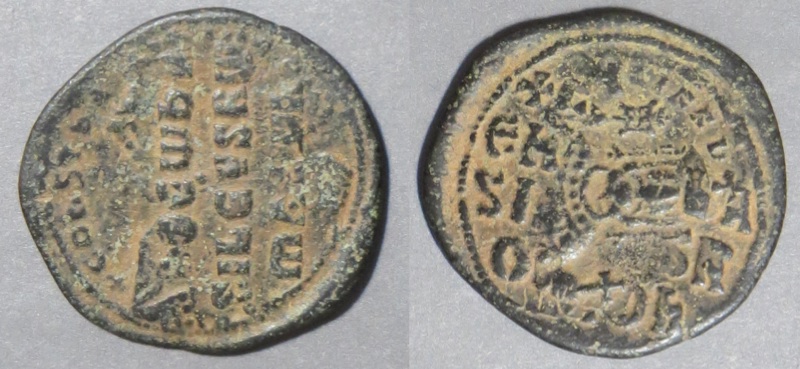 CONST bA is clear from 7:30 to 10:30 and the shoulder and right arm of Constantine VII are visible above 6:30. The left side of the head is visible just left of the "Wb" near 10:30, and the globus cruciger in his left hand shows at 3:00.
CONST bA is clear from 7:30 to 10:30 and the shoulder and right arm of Constantine VII are visible above 6:30. The left side of the head is visible just left of the "Wb" near 10:30, and the globus cruciger in his left hand shows at 3:00.
Under the bust of Nicephorus II we can see parts of the four-line legend of the undertype (here, slightly tilted from 9:20 to 3:30.
+COҺST
ЄҺOЄbA
SILЄVSR
ROMЄOҺ
Sear 1761 of Constantine VII alone is the undertype.
John I (969-976). Nicephorus II was assassinated by his successor, John I, Tzimisces, 969-976. The devout John initiated "anonymous folles"--folles without the issuing emperor's names--and has no copper coins from Constantinople in his own name. However, the outlying mint Cherson did issue one type with his monogram.
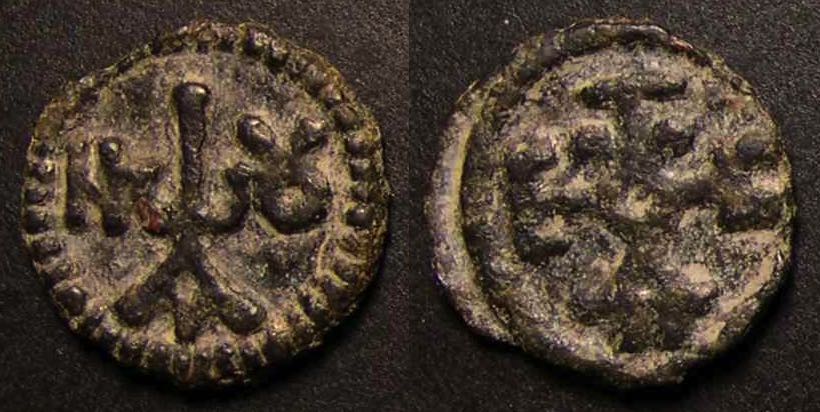
John I, 969-976.
17 mm. Cast. (Coins of Cherson after 829 were cast. It was the only mint to issue official cast coins.)
Monogram of John (in Greek)
IOANNOɣ
Monogram BACIΛIOɣ (emperor)
Sear 1794, Cherson mint.
Cast coins of Cherson are usually weak on one side and worse on the other, because casting does not impress a type well the way striking does. This example is among the best of its type.
 Anonymous follis of Class A1, attributed to John I.
Anonymous follis of Class A1, attributed to John I.
24-22 mm. 5.74 grams.
Facing nimbate bust of Christ with two dots in each limb.
+IhSUS
XRISTUS
bASILЄU
bASILЄ
with no decoration above or below.
The two dots and lack of decoration distinguish the coins attributed to John from coins attributed to later emperors. Many coins said to be (by ignorant sellers) Class A1 are really Class A2. Class A1 coins are never as large as most Class A2 coins which are usually 27-35 mm. Most Class A1 coins are under 25 mm and those few that are 25 mm or more are thinner and lighter than Class A2 coins.
For much more about anonymous folles, see my page here.
It is unfortunate for collectors that the named coins of the next several emperors are only in gold or silver, not copper. However, anonymous folles are common and scholars have worked to identify the emperors who issued the various classes (i.e. types). Their most-recent identifications are on my page. Every dealer selling an anonymous follis lists a name of a ruler associated with the type. Some of the names are certain and others are not so certain.
The period of anonymous folles had some interesting emperors, including Basil II, "The Bulgar Slayer." His life is full of interesting events, but he is best known for eliminating the threat of the Bulgars who had conquered most the Balkans. After some ups and downs, Basil defeated them in a battle in 1014 and instead of merely killing the 15,000 captives as would have been typical, he blinded 99 of every 100 and left one with only one eye to lead them back home. When the sorry train of disabled men reached the castle of the Bulgarian Tsar Samuel he was so upset he died in a fit of apoplexy. Leaderless, the Bulgars did not recover. The Byzantines reclaimed the entire Balkan peninsula. (Aside: Ancient and medieval times were amazingly brutal. Be glad we live in the 21st century and are so well-off that we can collect Byzantine coins.)
Here is an off-site map of Europe in AD 1000. (The Byzantine Empire is in pink. The empire includes only the regions of modern Greece and Turkey. The eastern border is further east than in 900, but is in flux.)
Nicephorus III (1078-1081). Some anonymous folles ["Class I"] have been attributed to the Byzantine emperor Nicephorus III (1078-1081). He has one other follis type that is not anonymous, Sear 1888. It is quite scarce (although low valued in Sear) and rarely comes at all nice (remember, we are discussing Byzantine copper). The Sear plate coin is not pleasing--the photograph is hard to decipher.
 Nicephorus III, 1078-1081.
Nicephorus III, 1078-1081.
23-22 mm. 5.55 grams.
Christ standing facing, IC XC either side, eight-pointed stars below, either side.
C Φ
N Δ
in quadrants of cross with big dot at each end. Eight-pointed star in circle.
According to Whitting, Byzantine Coins, the letters abbreviate
May the cross (C) protect (Φ)
Nicephorus (N) emperor (Δ) [Despot]
Expanded: CΦNΔ = Σταυρέ Φύλαττε Νικήφορον Δεπότη
O Cross, protect Nikephoros Emperor/Despotate
Sear 1888.
If you have an interest in Byzantine coins and don't have Whitting's Byzantine Coins, you are missing out on a lot of pleasure and information. It has many excellent enlarged photographs and a lot of commentary.
Alexius I (1081-1118). The anonymous follis period lasted from 970 to about 1092 during the reign of Alexius I who issued the last anonymous folles and then reformed the coinage to include new denominations. Most of his base-metal coins have his name on them and he issued more different types than previous emperors. In the middle Byzantine coinage era (c. 700 to c. 1092) each emperor had only a few copper types. Starting with Alexius emperors have numerous types.
Alexius I, 1081-1118, reformed the coinage c. 1092 to include cup-shaped coins ("trachy") in gold, electrum (a gold-silver alloy), and a base-silver ("billon") alloy.
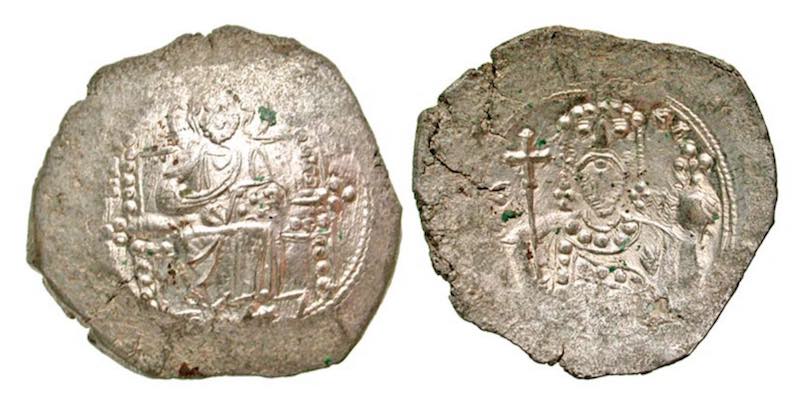
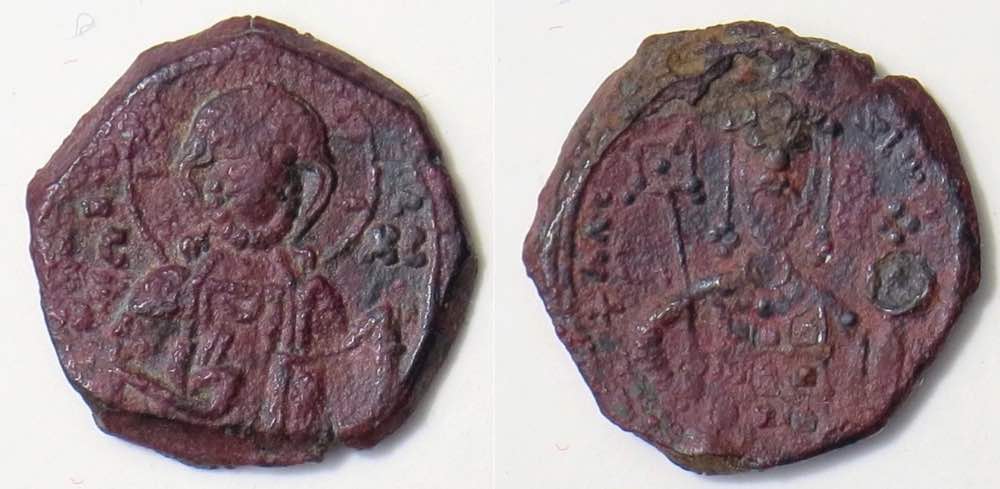 Alexius I, 1081-1118
Alexius I, 1081-1118
18 mm. 3.94 grams.
A new denomination, the "tetarteron."
Bust of Christ facing
Bust of emperor holding labarum and globus cruciger.
AΛЄ ....
Sear 1931. Constantinople mint.
The next page resumes with copper types from later emperors.
Go to the next page, "Late Byzantine AE, 1059-1204 (Constantine X to the fall of Constantinople to the crusaders)."
Return to page 1 and its Table of Contents to "Introduction to Byzantine coins".
Return to page 2, "Byzantine-Coin Letters, Numerals, Denominations, and Dates."
Go to the Table of Contents of this whole educational site.